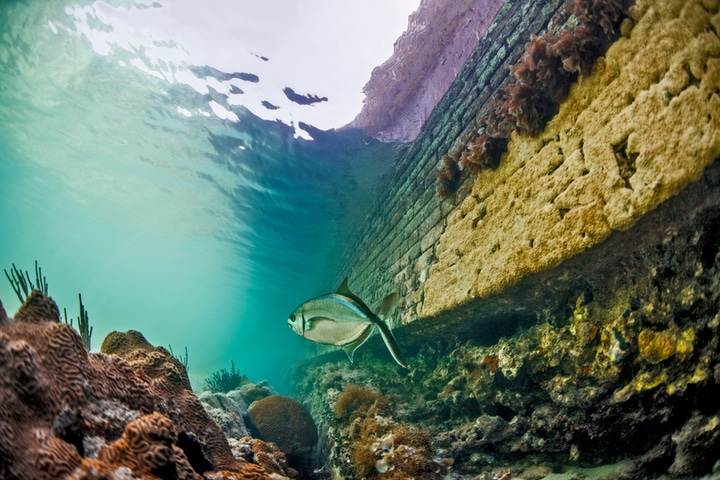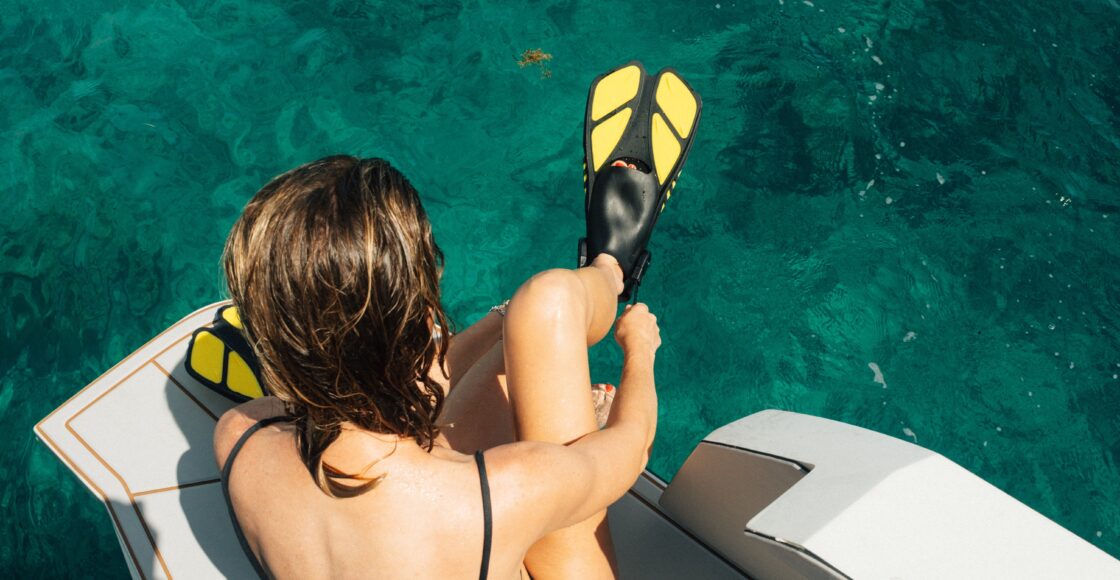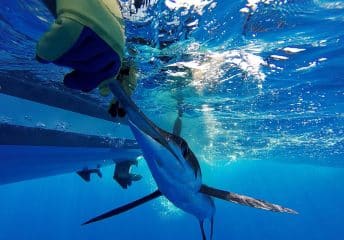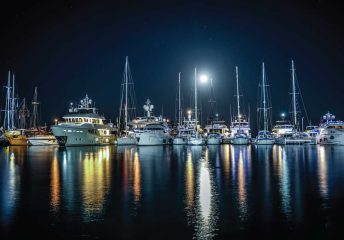Snorkeling in Miami: Best Spots to Visit
Last Updated on November 4, 2025 by Boatsetter Team
Miami’s snorkeling potential is seriously underrated. From shallow reefs and wrecks in Biscayne Bay to deeper Atlantic flats just minutes offshore, you’ll find marine life and coral environments that rival most tropical destinations. Whether you’re planning a guided charter or a casual family outing, here are the top snorkeling spots in the Miami region — what to expect, how to get there, and how to make it memorable.
Vista Park Reef
Location: Vista Park Beach, Miami Beach
What to Expect: A short swim from shore brings you to clear water and scattered coral structures. Ideal for families or newer snorkelers who don’t want a long boat ride. Visibility is often excellent thanks to the shallow depth.
Boatsetter Tip: Bring underwater-camera ready gear — you’ll capture tropical fish, spadefish and damselfish in surprisingly clear water.
Maritime Heritage Trail (Biscayne National Park)
Location: Biscayne Bay, east of Key Biscayne
What to Expect: A collection of reefs and wrecks — like Half Moon Reef and Emerald Reef — that host diverse marine life: manatees, nurse sharks, starfish, parrotfish, tropical coral species and more.
Boatsetter Insight: Booking a boat from Miami with a captain experienced in Biscayne Bay gives you access to reef locations that aren’t reachable from land. Ideal for snorkelers who want more adventure.
Sitting right across Biscayne Bay from Miami, Biscayne National Park is 173,000 acres and is 95% water. It protects mangrove forests, coral reefs, islands, marshes, swamps, aquatic life, and its section of the ocean.
At Biscayne National Park, you’ll find the Half Moon Reef, Bear Cut Reserve, Emerald Reef, and the Maritime Heritage Trail. This is one of the more interesting and action-packed locations because of the underwater sights, intrinsic corals, and marine life. This area is full of sea turtles, nurse sharks, stingrays, starfish, hogfish, parrotfish, angelfish, manatees, and bottlenose dolphins.
Half Moon Reef and Half Moon Reserve is a twelve-foot-deep reef home to the Half Moon Shipwreck. In the early 1900s, the Halfmoon yacht was one of the fastest boats of its time. After winning the German Kaiser’s Cup, the English captured the yacht in World War I. Eventually, it was purchased by Earnest D. Smiley, who anchored it in Biscayne Bay, and converted it into a restaurant. A difficult storm broke the moorings not long after this, and it sank beneath the bay. It remains to this day and is a hot spot for snorkelers of all experience levels.
Emerald Reef is a novice-friendly shallow reef in clear-blue water. It is a mile east of Key Biscayne and runs between ten to twenty feet deep. It primarily houses Pillar coral and Elkhorn coral and other species. Starfish, manatees, spadefish, and bottlenose dolphins also make frequent appearances in this location, so get that underwater camera ready!
Hollywood North Beach Park
Location: North Ocean Drive, Hollywood, FL
What to Expect: Deeper water (10-20 ft) and a mix of marine life including barracuda, tarpon, snook and nurse sharks. While this is technically a short drive from Miami, it’s a strong choice for guests staying downtown who want a quieter spot. Hollywood North Beach is such a beautiful area; you’ll want to take a moment on the beach to take it all in and appreciate the scenery. Swim out from the lifeguard tower and head into the sand patches.
Boatsetter Tip: Launch earlier in the day when conditions are calmer. This spot offers good variety for intermediate snorkelers.
Neptune Memorial Reef
Location: Offshore, near Key Biscayne
What to Expect: An artificial reef known for its creative structures and dense coral growth. It’s not your typical beach snorkel — but for those comfortable with a deeper boat ride, it offers vibrant visuals and unique underwater architecture. It’s the largest artificial reef ever made globally, and while it’s only an acre now, it will soon cover sixteen acres of the ocean floor. Fourteen species of coral live here now, meaning that it can now be classified as a true reef. It has remarkable colors and abundant, healthy, and biodiverse marine life living within it. The reef is also a place for people to remember and honor their loved ones. The reef combines cremation ashes with natural concrete to create free-standing memorial pieces, such as dolphins, turtles, starfish, shells, manatees, stingrays, and octopi, to add to the reef. This is one of the few places on earth where pet ashes and human ashes can be combined.
Boatsetter Insight: Large charters that include snorkeling and sightseeing routes can differentiate their listing by including this location.
Dry Tortugas National Park in Key West
This special national park comprises small, clustered islands in the Gulf of Mexico. You can only access it by boat or seaplane (or submarine if you’re feeling extra fancy).

Here you can explore warm, shallow waters only about ten feet deep, with coral, tropical fish, conch, and starfish. After you’ve finished snorkeling, check out what’s left of the Fort Jefferson ruins on the islands.
The address: Dry Tortugas National Park, Florida, USA
John Pennekamp Coral Reef State Park
This twenty-one-mile-long, three-mile-wide park was the first underwater park in the United States, and it offers nearly seventy nautical miles of fantastic underwater sights. The beach has lots of small pebbles, so you must be careful and wear appropriate attire while on it.
There is a healthy reef, colorful coral, and several underwater figurines and statues. It is home to the only living coral reef in the contiguous United States.
Yankee Clipper Reef / Yankee Clipper Rocks
This warm reef is filled with interesting drop-offs, steep ledges, and rocky coral reefs. The depth ranges from six to fifteen feet deep. You’ll find sea whips, soft coral, smaller sharks, and more. This area is easy to access; simply in the spacious parking lot at Lago Mar Beach, and then walk down to the shore. You’ll have to go about 60 to 80 feet into the water before finding the reef.
Pompano Beach Drop Off
About a half-mile to the south of the Pompano Pier, you’ll find the drop-off. The drop-off ranges from six to twenty-two feet deep and is home to sponges, assorted vibrant coral species, sea whips, and small sharks. Learn more about Fort Lauderdale Snorkeling spots.
Can you snorkel off the beach in Miami?
You can snorkel off the beach in Miami. South Beach is sometimes said to be too sandy and cloudy for snorkeling, but you just need to find the right places to go. Nearby Biscayne National Park, Key Largo, and Looe Key are great options too, because the water is clearer, blue, and filled with many species of coral, fish, and other forms of marine life, like manatees, dolphins, sea turtles, and important waterfowl and birds of prey.
Key Largo sits adjacent to South Beach, and it is the largest coral barrier reef in the world. It’s also the only living coral barrier reef in North America, making it even more fascinating.
There are several different types of snorkeling opportunities in the area, meaning that there is something for everyone from the brand new novice to the best of the best experts.
Are there coral reefs near Miami Beach?
Yes, there are several coral reefs near Miami Beach and South Beach.
The Florida Reef Tract runs right by Miami and Miami Beach. This spectacular reef is colorful, with vibrant pops of red, yellow, blue, purple, and even pink, and it is so full of life. It stretches from Miami to the Florida Keys, westwards past Key West, and then to the Dry Tortugas Islands.
Some of these reefs are natural, and some are artificially created.
You’re most likely going to see stingrays, spiny lobsters, parrotfish, yellowtail snappers, angelfish, blue tang, hogfish, grouper, bottlenose dolphins, manatees, sea turtles, nurse sharks, conchs, and starfish. The most common types of coral are Ivory Bush, Mustard Hill, Staghorn, Clubbed Finger, Elkhorn, Lettuce, Grooved, Boulder, Great Star, and Massive Starlet Coral.
Not all of these incredible snorkeling sites are available by car or land, so you’ll need a boat. With Boatsetter, you can find hundreds of boat models in the Miami area that are perfect for a snorkeling expedition. Find the best boat rental in Miami for your next snorkeling adventure.
Planning Your Snorkeling Trip
- Choose a boat with swim ladder access, shade, and secure gear storage.
- Pack reef-safe sunscreen — coral systems are sensitive and local zones may enforce protection.
- Bring your own mask, snorkel, and fins for comfort — rental gear is fine, but fit matters for long swims.
- Coordinate with your captain about current conditions, tide flow and entry/exit routes.
- Boatsetter Insight: Listings that mention “snorkel gear included” or “reef stop” frequently rank higher for guests looking for water-based experiences.

Boatsetter empowers people to explore with confidence by showing them a world of possibility on the water. Rent a boat, list your boat, or become a Boatsetter captain today.










